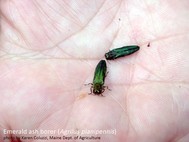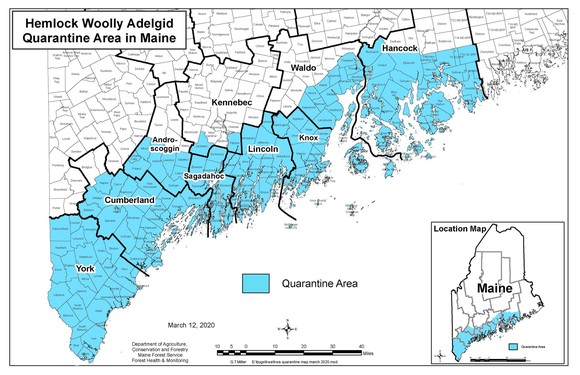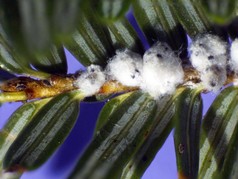Insect & Disease Conditions Update
The Maine Department of Agriculture, Conservation and Forestry has announced revisions to the quarantine rules for both emerald ash borer (EAB) and hemlock woolly adelgid (HWA). The revisions are identical to those published for public comment in late-January.

The emerald ash borer (EAB) quarantine area within Maine has expanded due to new detections of EAB in southern Maine near and outside the boundaries of the previous quarantine area. The expansion is designed to capture the likely extent of the infested areas in southern Maine, given our knowledge of how quickly the insect spreads naturally. Major additions include the northern half of Cumberland County and the five southernmost towns in Oxford County. The complete area in Maine under quarantine for EAB now includes all of Cumberland and York Counties and parts of Aroostook and Oxford Counties (visit maine.gov/eab to view a map)
|

The quarantine rule bans movement of ash nursery stock from the quarantine area, and regulates the movement of hardwood firewood, hardwood chips, and ash products with bark, such as logs, pulp, and untreated ash lumber (see table below). Maine Department of Agriculture, Conservation and Forestry staff, together with the U.S. Department of Agriculture, Animal and Plant Health Inspection Service, Plant Protection and Quarantine are working with the public and impacted industries to ensure compliance with the quarantine. Visit the FAQ section of maine.gov/eab to learn more.
Below is a general overview of what can and cannot move freely from EAB regulated areas:
|
What Can be Moved from an EAB Regulated Area without EAB-related Documentation?*
|
What Needs Additional
EAB-Related Documentation and Treatment to Move from an EAB Regulated Area?**
|
What Cannot be Moved from an EAB Regulated Area?
|
|
Hardwood roundwood (logs, pulp, etc.) without ash
Softwood roundwood
Softwood chips
|
Ash roundwood (logs, pulp, etc.)
Ash lumber
Hardwood chips or grindings with or without ash
Hardwood firewood
|
Rooted ash (ash seedlings, saplings and trees)
Emerald ash borer
|
*Other quarantines may apply
**All the products listed in the middle column need documentation year-round from Maine Department of Agriculture, Conservation & Forestry, Maine Forest Service. Treatment requirements vary by product and may vary by time of year.
This announcement comes at an important time of year as we are quickly approaching EAB flight season. The flight period for EAB begins May 1st, when adult beetles can begin emerging from infested trees or other ash products. The majority of new EAB infestations are the direct result of human-assisted movement. Many of them, a result of movement of infested firewood. We ask readers to both abide by and help spread the messages:
More information on EAB quarantine regulations and how to recognize and report its damage can be found at: www.maine.gov/eab.
Rule text can be found at: https://www.maine.gov/dacf/php/plant_health/statutes_rules.shtml, Chapter 275
The area under quarantine in Maine due to hemlock woolly adelgid (HWA) has increased to reflect detections of HWA in the forests of Midcoast Maine and ornamental trees in coastal Hancock County. Repeated detections of HWA in ornamental trees in coastal Hancock County are an important reason for the expansion, highlighting the role of landscaping activities in the human-assisted spread of this forest pest. The complete area under quarantine for HWA in Maine now includes all of Knox, Lincoln, Sagadahoc and York Counties and portions of Androscoggin, Cumberland, Hancock, Kennebec, and Waldo Counties.

This quarantine continues to regulate rooted hemlock seedlings and nursery stock, hemlock branches and/or needles, chips containing branches and/or needles, and uncomposted bark containing branches and/or needles (see table below).
|
What Can be Moved from an HWA Regulated Area without Impacts from this Quarantine Regulation?*
|
What Needs to go to a Destination with a HWA-Related Compliance Agreement to Move from an HWA Regulated Area?
|
What Cannot be Moved from an HWA Regulated Area?
|
|
Products free from hemlock
Hemlock roundwood without branches
Bole (stem only) chips, grindings, or bark without hemlock branches or needles
|
Chips or grindings with hemlock branches or needles
Uncomposted bark with hemlock branches or needles
Hemlock branches
|
Rooted hemlock
Hemlock woolly adelgid
|
*Other quarantines may apply

Often over-looked, clusters of HWA appear as small cotton-ball like masses on the undersides of hemlock twigs. They can be easily identified when viewed up close. If you suspect you have seen HWA, mark the branch, take a picture or sample and contact the Maine Forest Service. Report suspected HWA online or call (207) 287-2431.
Additional information on HWA quarantine regulations and how to recognize and report its damage can be found at: www.maine.gov/forestpests#hwa
Rule text can be found at: https://www.maine.gov/dacf/php/plant_health/statutes_rules.shtml, Chapter 266.
Image courtesy USDA Forest Service
|
Questions about Forest Products? Contact Mike Parisio at (207) 287-7094
Questions about Hemlock Nursery Stock or Seedlings? Contact Gary Fish at (207) 287-7545
|